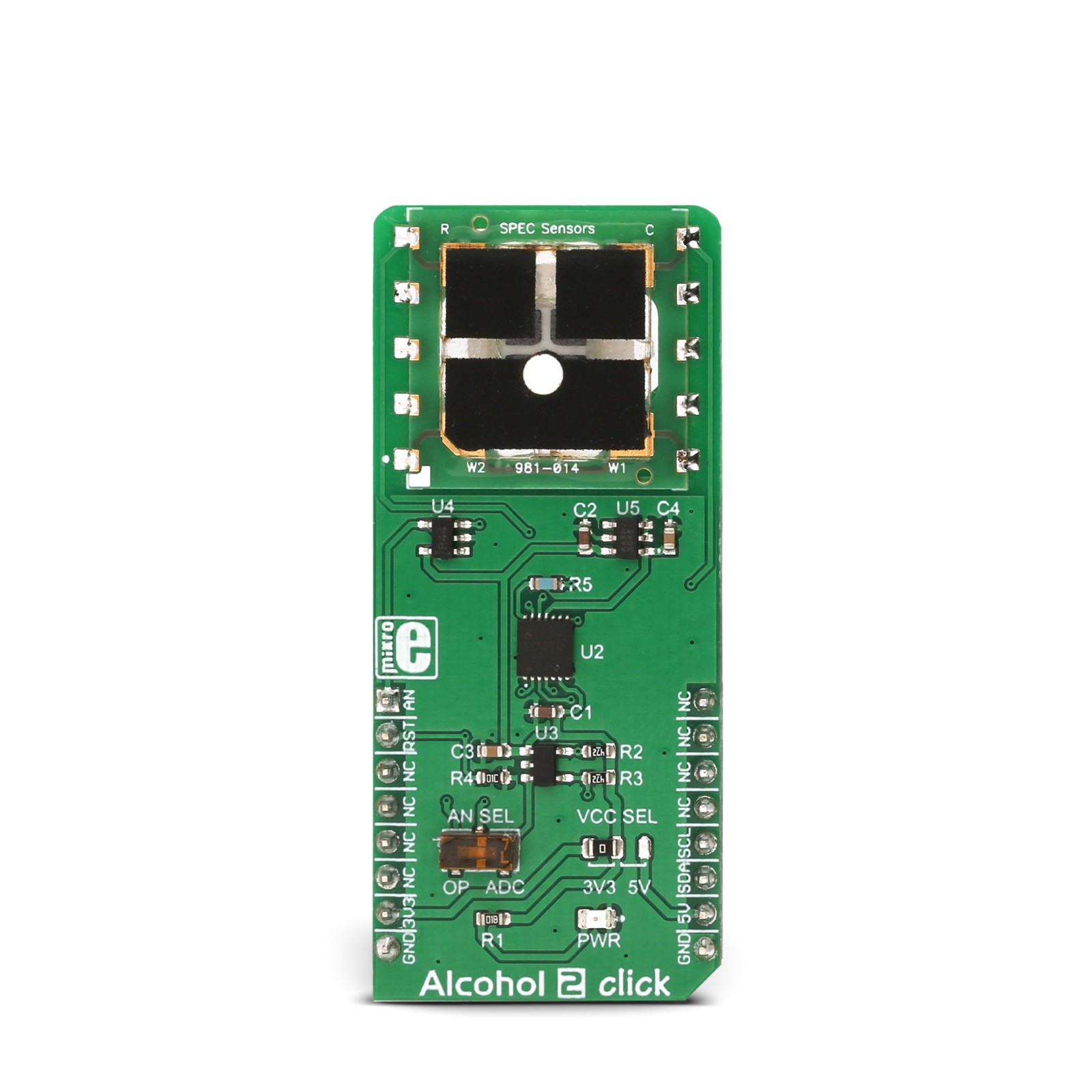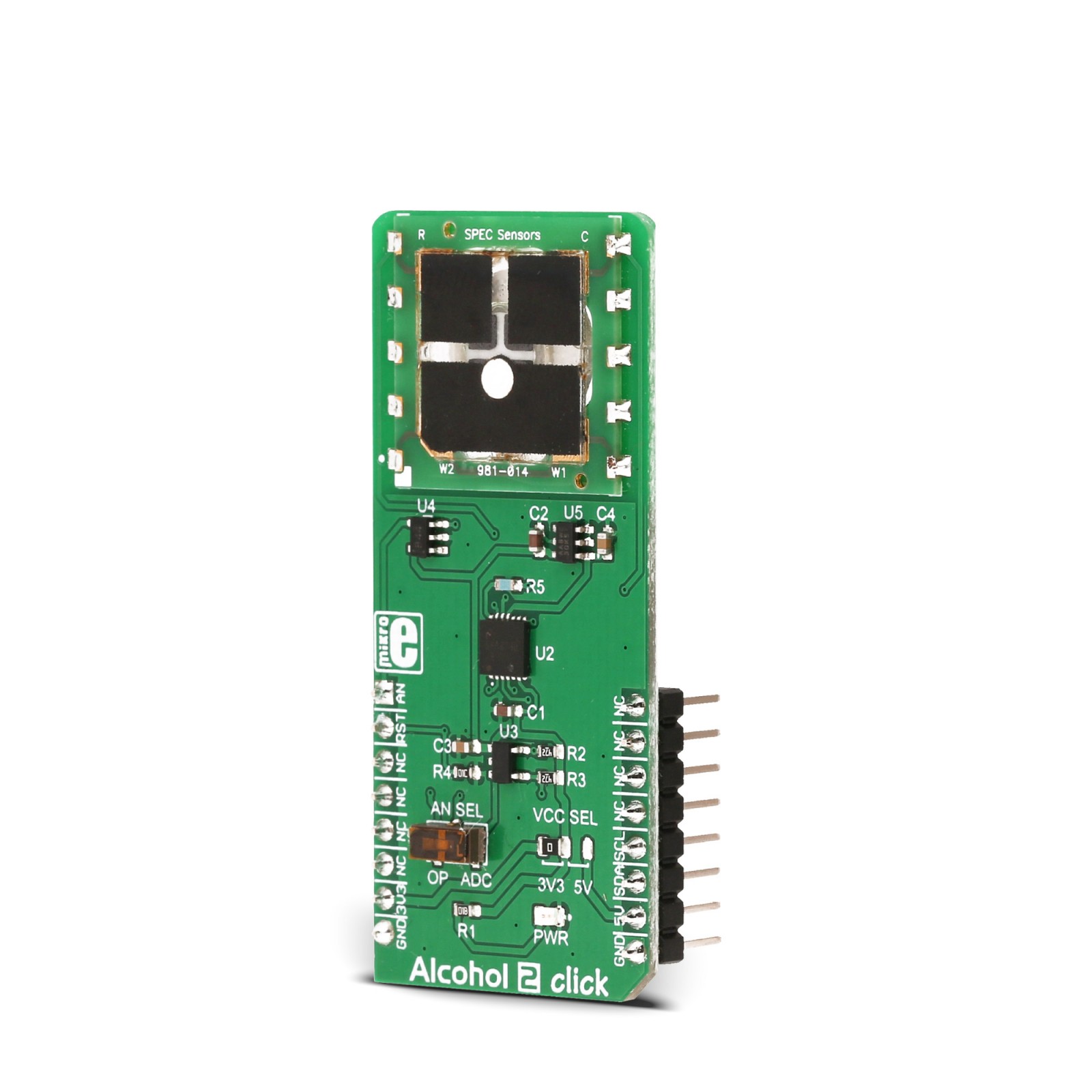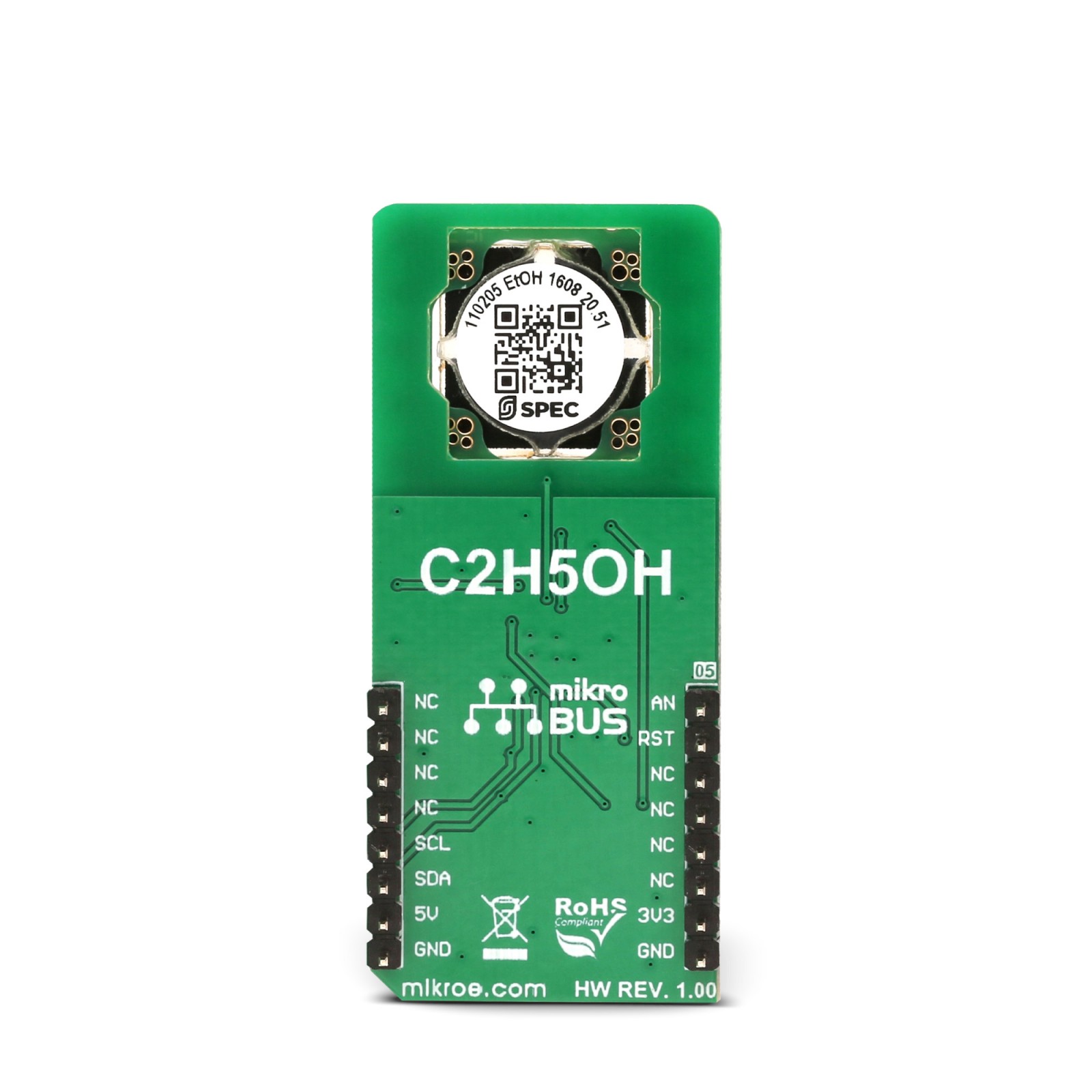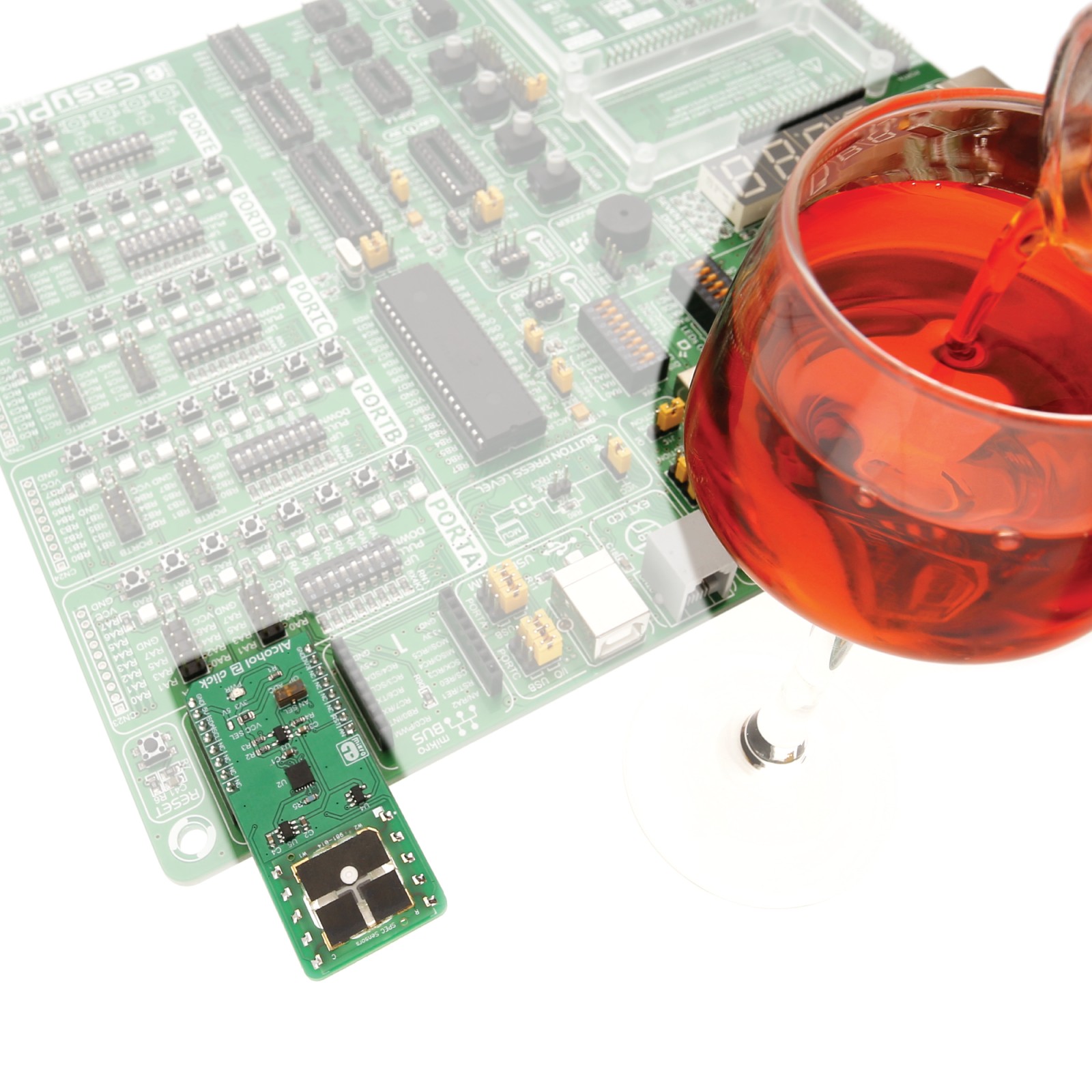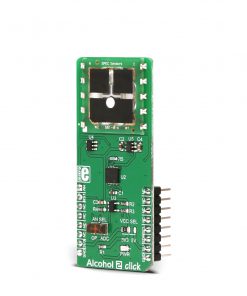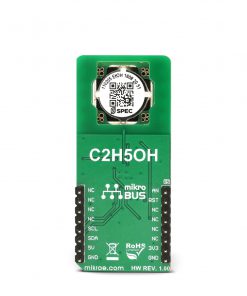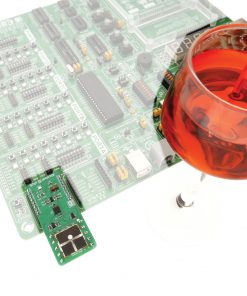Subtotal: R4,600.00
Alcohol 2 Click
R1,400.00 ex. VAT
Alcohol 2 click is a very accurate ethanol gas (alcohol) sensor Click board™, equipped with the SPEC amperometric gas sensor which electrochemically reacts with the ethanol. It is supported by the LMP91000, a high-precision integrated analog front-end IC (AFE), perfectly suited for use in electrochemical sensing applications. The Click board™ also provides the reference voltage required by the sensor and offers a choice between the analog output from the AFE IC buffered with the low noise op-amp, and digital output from the 12-bit SAR A/D converter.
Stock: Lead-time applicable.
| 5+ | R1,330.00 |
| 10+ | R1,260.00 |
| 15+ | R1,190.00 |
| 20+ | R1,145.20 |
The AFE IC provides a unified platform for many types of electrochemical sensors and as such, it packs a range of different features which simplify the use of various electrochemical sensors. The AFE IC supports gas sensitivity in a range from 0.5 nA/ppm to 9500 nA/ppm. Equipped with the SPEC ethanol sensor with resolution of 5ppb, the Click board™ can be used for various alcohol breathalyzer applications, alcohol breath testers, atmospheric ethanol presence detection applications, and similar.
How does it work?
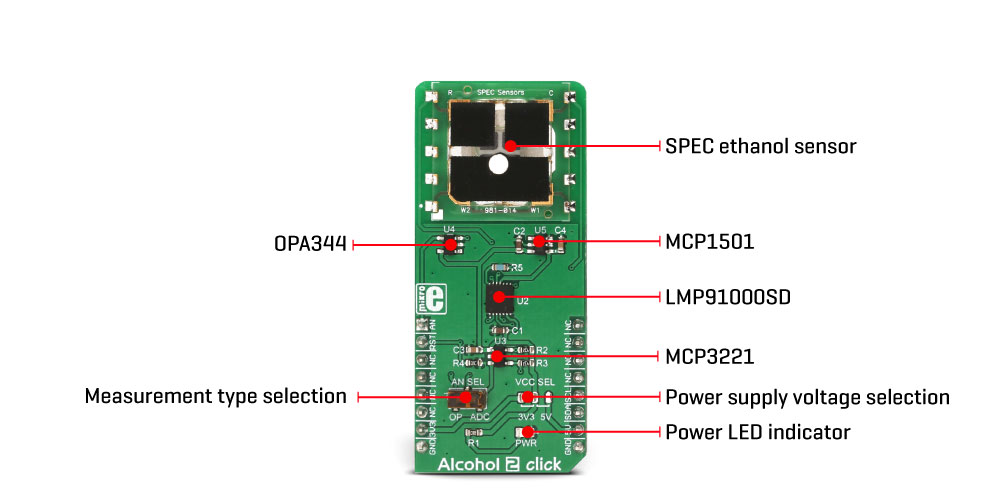
The RST pin on the mikroBUS™ is routed to the MEMB pin of the LMP91000 and it is used to enable the I2C interface section, thus making it possible to use more than one chip on the same I2C bus. When it is driven to a LOW logic level, the I2C communication is enabled and the master device (host MCU) can issue a START condition. The RST pin should stay at LOW during the communication.
This Click board™ can work with both 3.3V and 5V. An SMD jumper labeled as VCC SEL can be moved to the desired position, allowing both 3.3V and 5V MCUs to be used with this Click board™.
Specifications
Type
Alcohol,Gas
Applications
It can be used for various breathalyzer applications, alcohol breath testers, atmospheric ethanol presence detection applications, and similar
On-board modules
LMP9100SD, an integrated AFE for chemical sensing applications, MCP3221, a 12-bit SAR ADC from Microchip, OPA344, an operational amplifier from Texas Instruments, MCP1501, a high precision buffered reference, from Microchip
Key Features
High accuracy and repeatability of the measurements, ability to obtain measurement data in both analog and digital form, low cross-sensing for other gases, rapid response time, long lifecycle of the ethanol sensor
Interface
Analog,I2C
Feature
No ClickID
Compatibility
mikroBUS™
Click board size
L (57.15 x 25.4 mm)
Input Voltage
3.3V or 5V
Pinout diagram
This table shows how the pinout on Alcohol 2 click corresponds to the pinout on the mikroBUS™ socket (the latter shown in the two middle columns).
Onboard jumpers and settings
| Label | Name | Default | Description |
|---|---|---|---|
| LD1 | PWR | – | Power LED indicator |
| JP1 | VCC SEL | Left | Power supply voltage selection |
| SW1 | AN SEL | Right | Measurement type selection |
Alcohol 2 click electrical specifications
| Description | Min | Typ | Max | Unit |
|---|---|---|---|---|
| Measurement range | 0 | – | 1000 | ppm |
| Response time | – | 180 | – | s |
| Operating Temperature Range (recommended) | -20 | – | 40 | ˚C |
| Operating Humidity Range (non-condensing) | 0 | – | 100 | % RH |
Software support
We provide a demo application for Alcohol 2 click on our Libstock page, as well as a demo application (example), developed using MikroElektronika compilers. The demo can run on all the main MikroElektronika development boards.
Library Description
The library initializes and defines the I2C bus driver and drivers that offer a choice for writing data in a register. The library includes the function for reading the Alcohol data.
Key functions :uint16_t alcohol2_readAlcohol() - Function for reading the Alcohol datavoid alcohol2_writeByte( uint8_t reg, uint8_t _data ) - The function writes one byte to the register.
Example description
The application is composed of three sections:
- System Initialization – Initializes I2C bus and set AN pin as INPUT and RST pin as OUTPUT.
- Application Initialization – Initializes I2C driver and device configuration.
- Application Task – (code snippet) – Gets Alcohol (C2H5OH) data and logs data to USBUART every 500ms.
void applicationTask()
{
Alcohol_Value = alcohol2_readAlcohol();
FloatToStr( Alcohol_Value, demoText );
mikrobus_logWrite( "Alcohol value : ", _LOG_TEXT );
mikrobus_logWrite( demoText, _LOG_LINE );
Delay_ms( 500 );
}
The full application code and ready to use projects can be found on our LibStock page.
mikroE Libraries used in the example:
- I2C
- Conversions
Additional notes and information
Depending on the development board you are using, you may need USB UART click, USB UART 2 click or RS232 click to connect to your PC, for development systems with no UART to USB interface available on the board. The terminal available in all MikroElektronika compilers, or any other terminal application of your choice, can be used to read the message.
mikroSDK
This click board is supported with mikroSDK - MikroElektronika Software Development Kit. To ensure proper operation of mikroSDK compliant click board demo applications, mikroSDK should be downloaded from the LibStock and installed for the compiler you are using.
For more information about mikroSDK, visit the official page.
Resources
Downloads
| Weight | 21 g |
|---|---|
| Brand | MikroElektronika |

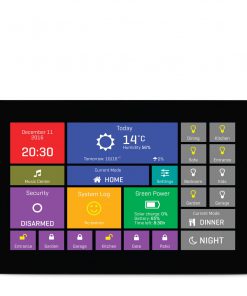 mikromedia HMI 7" UXB
mikromedia HMI 7" UXB 